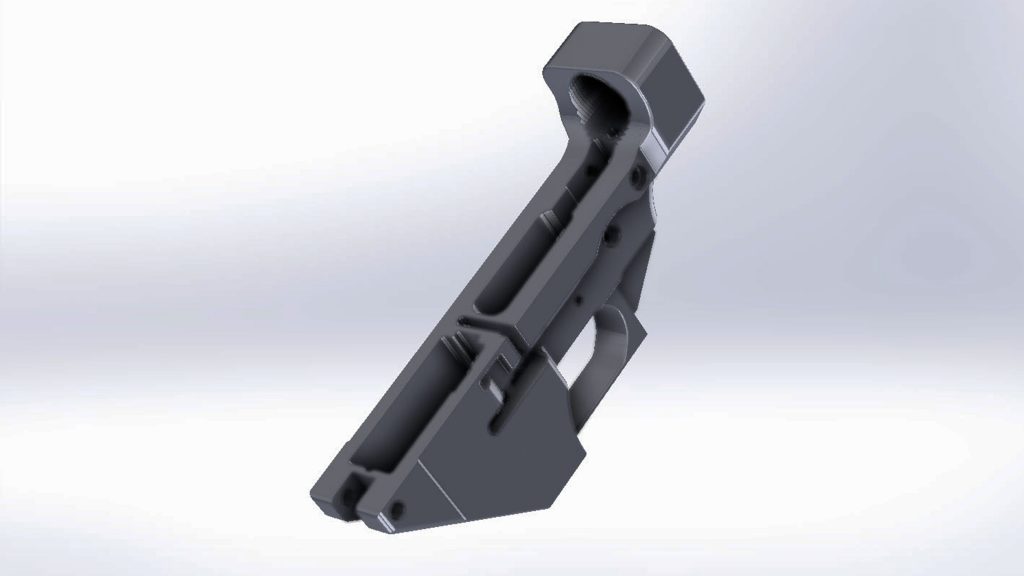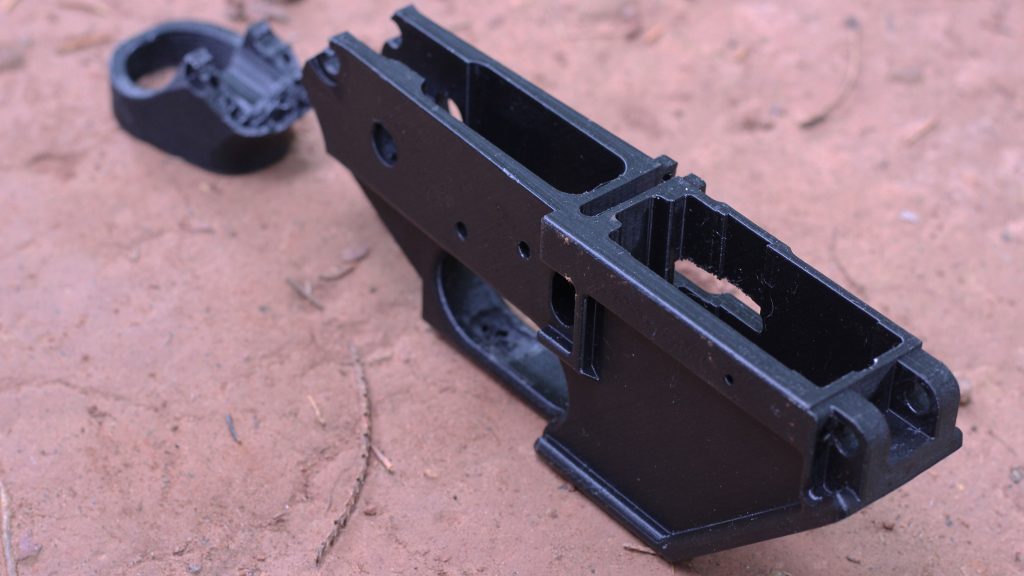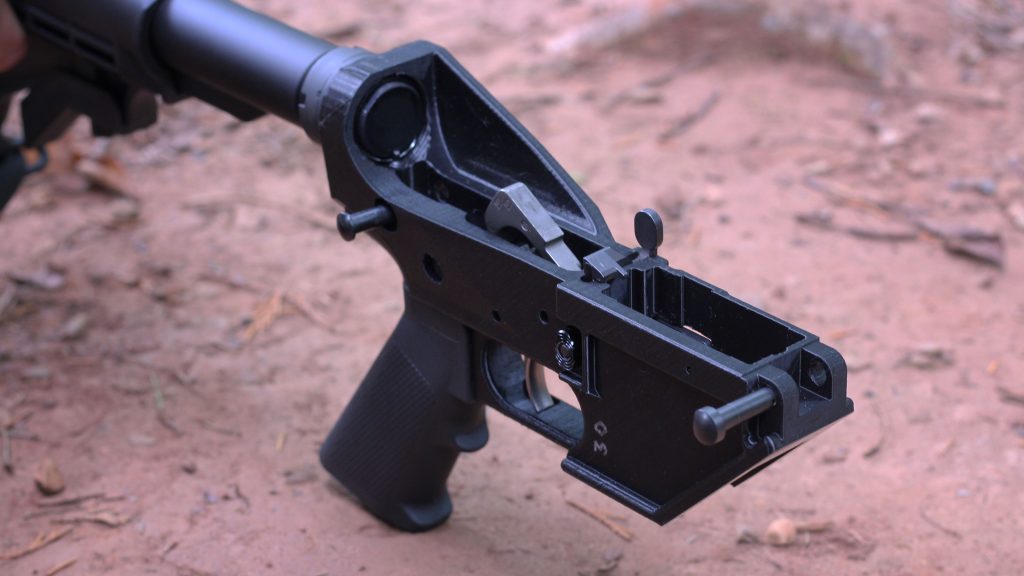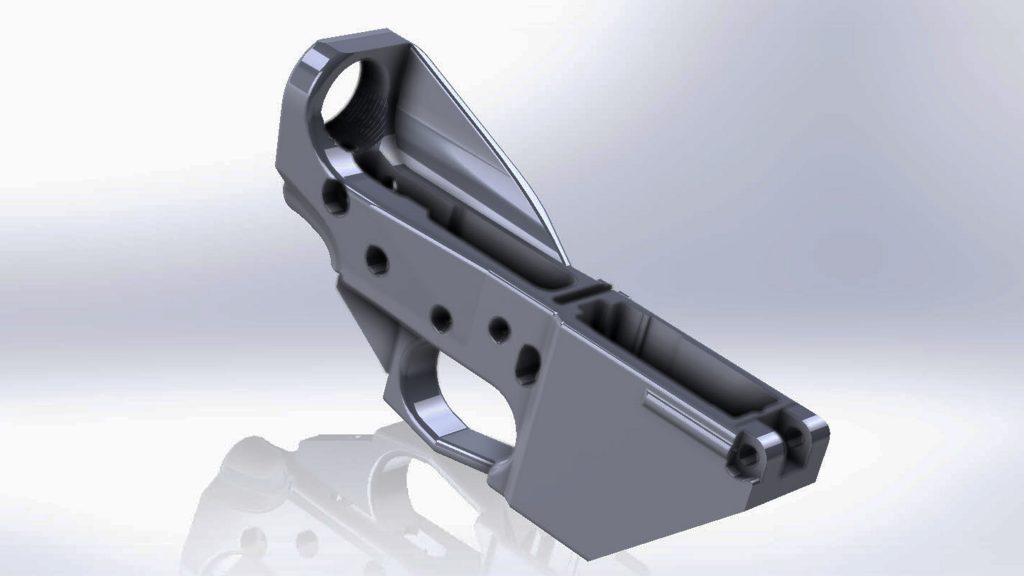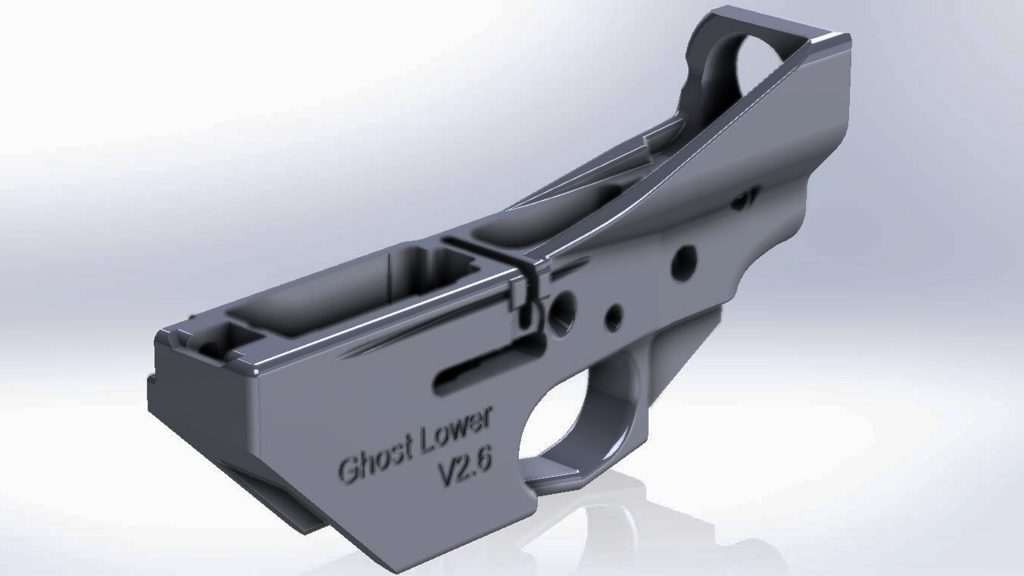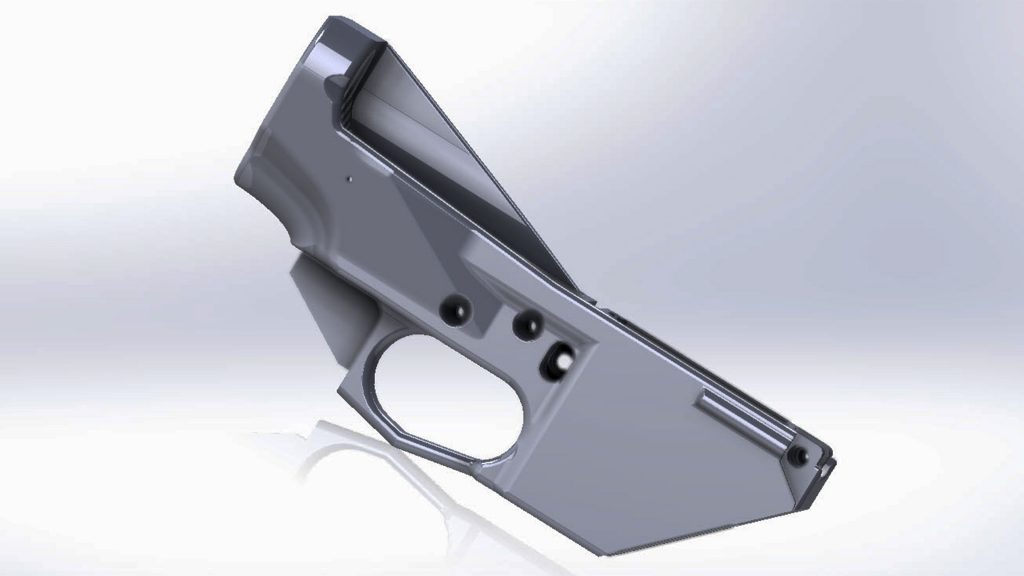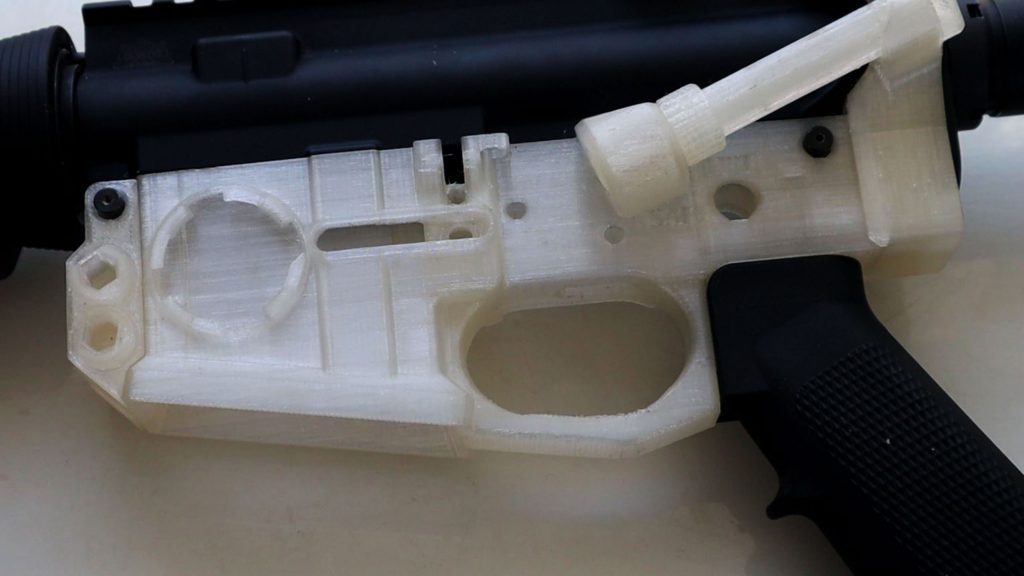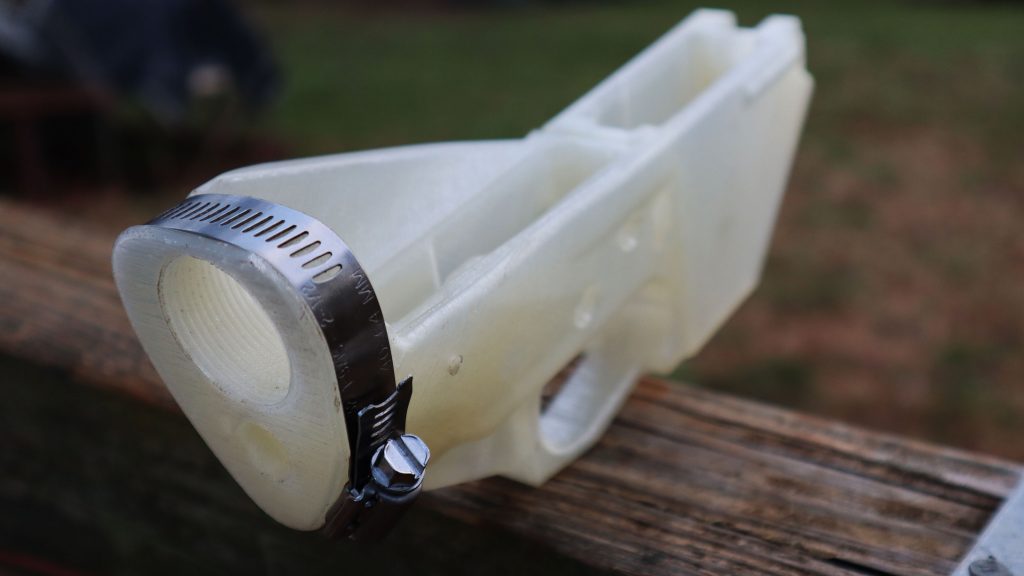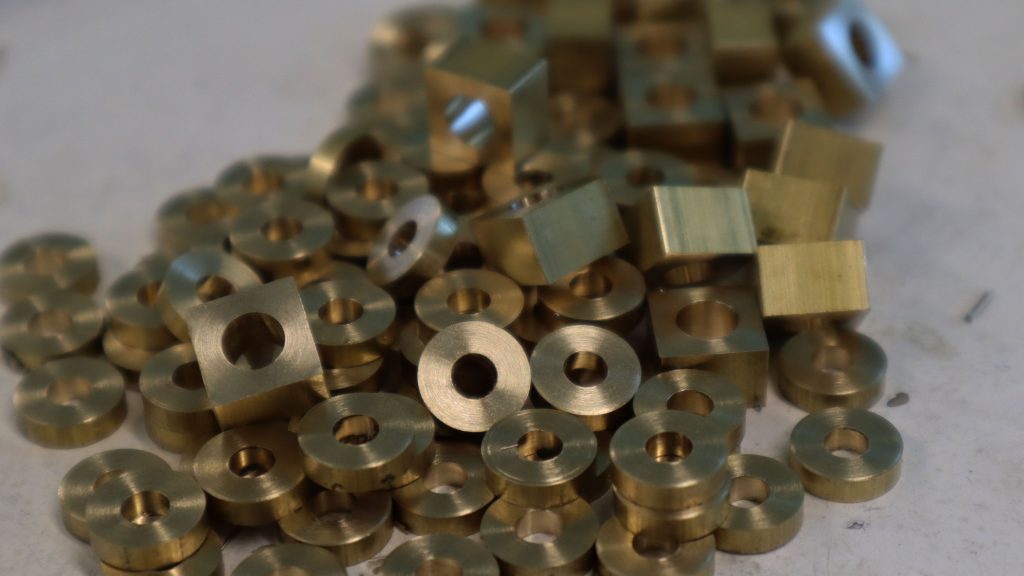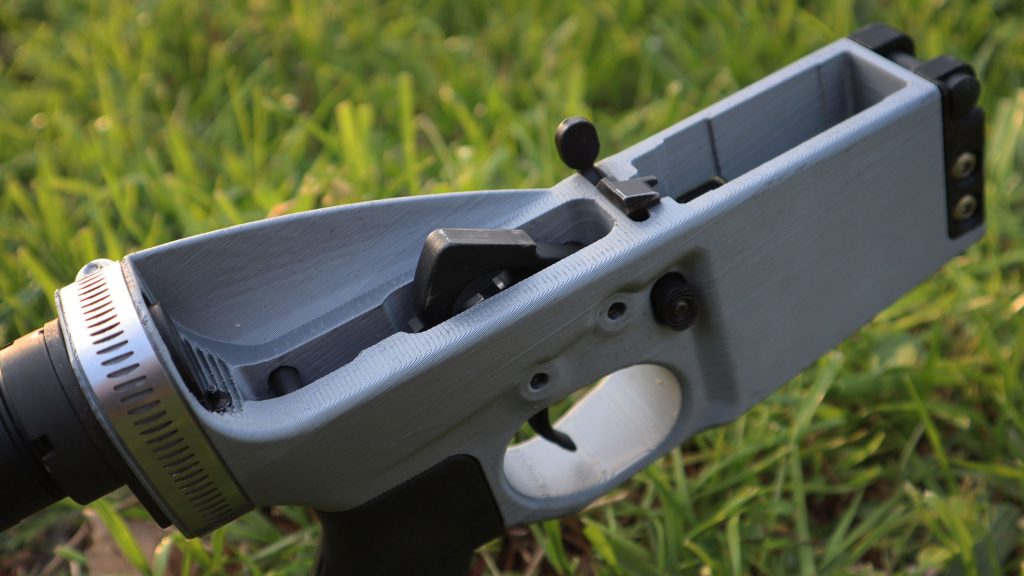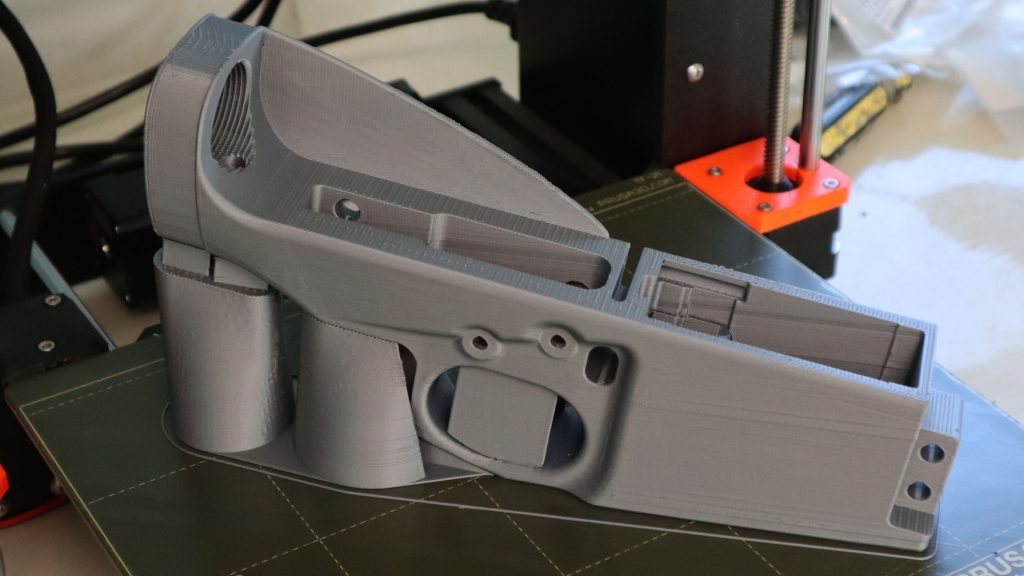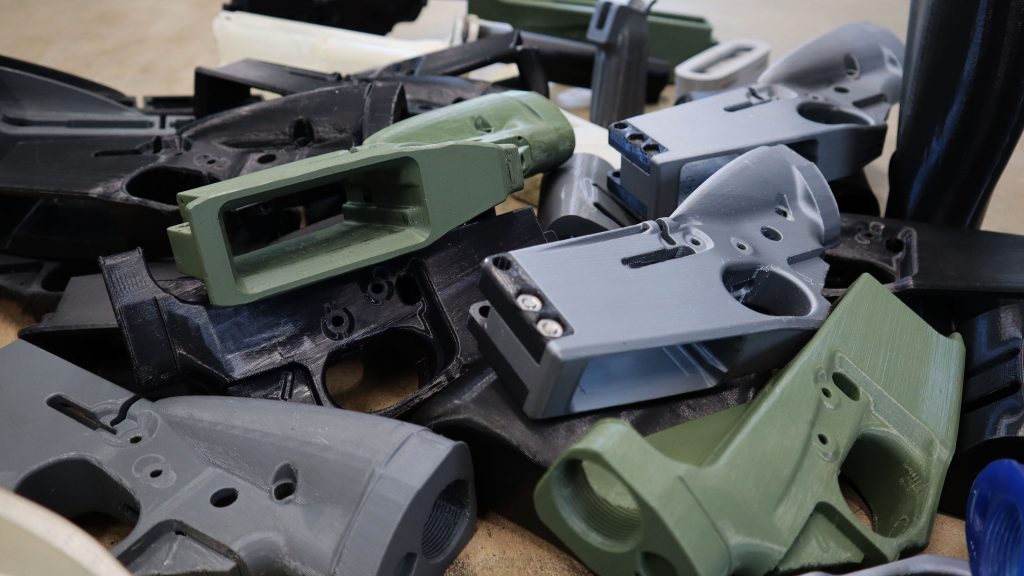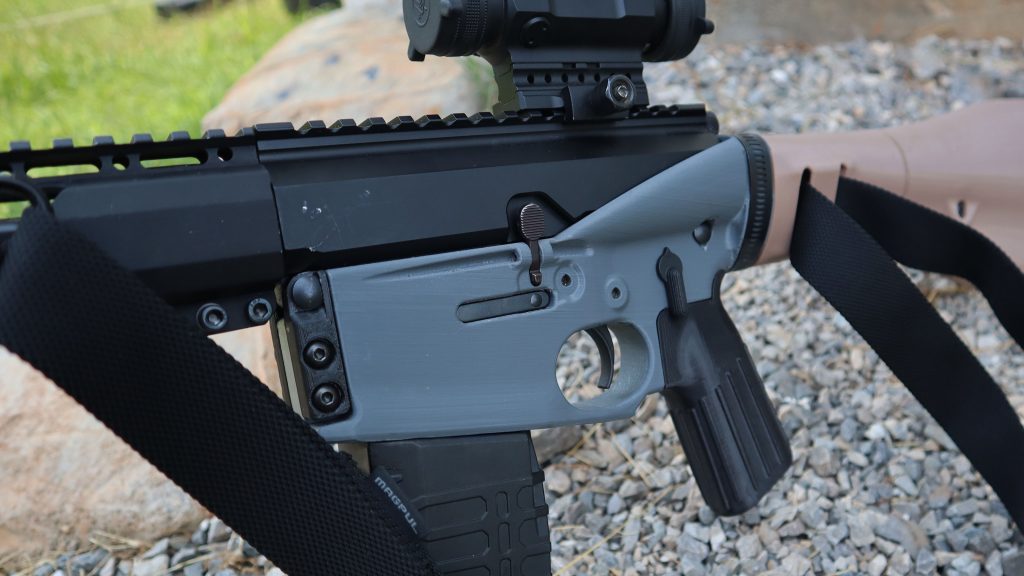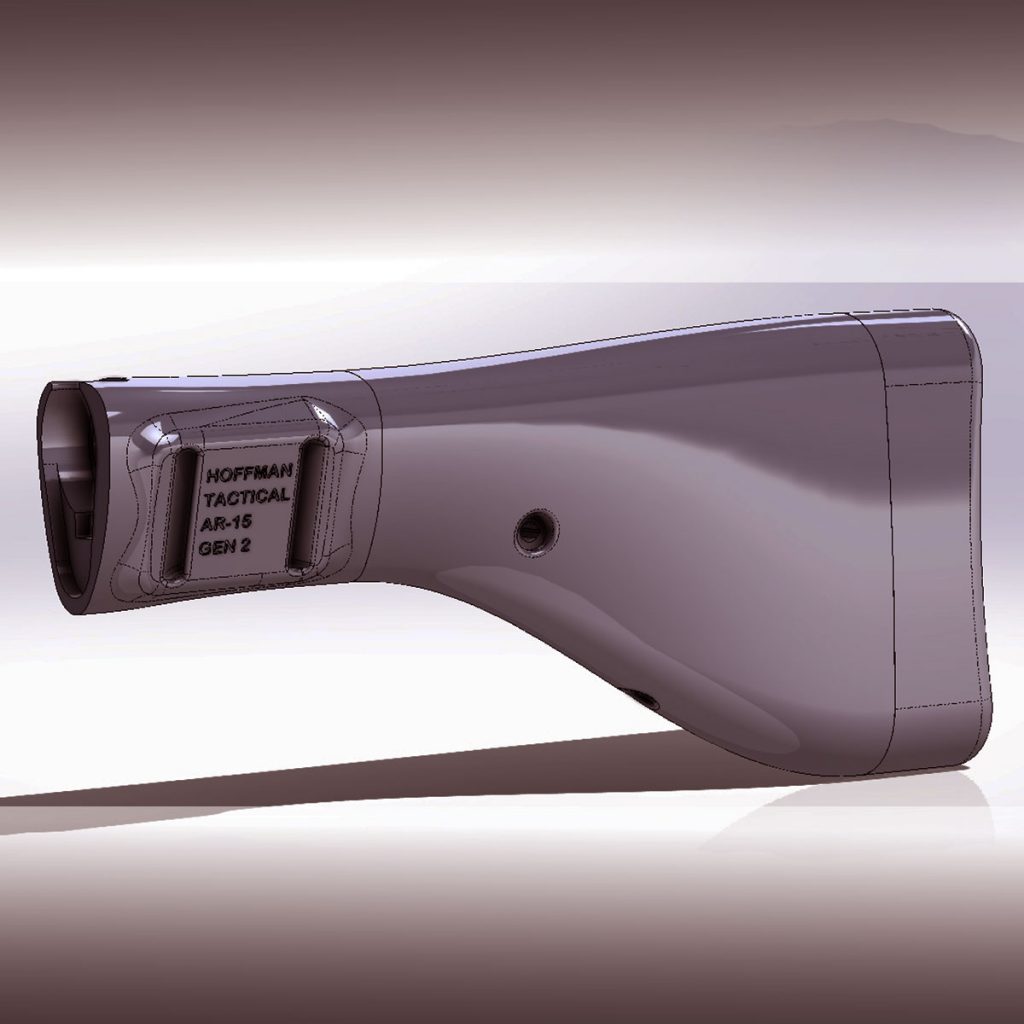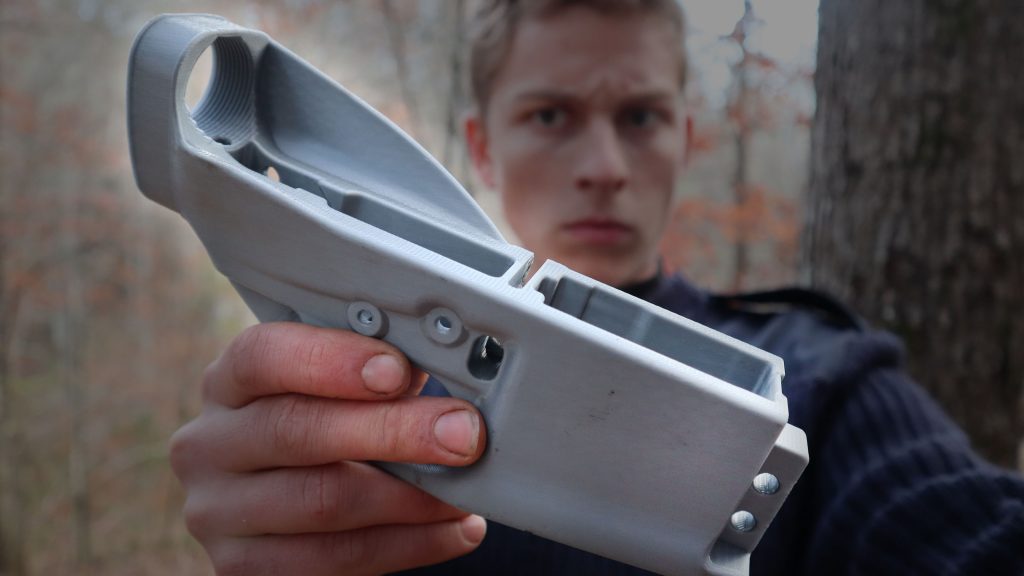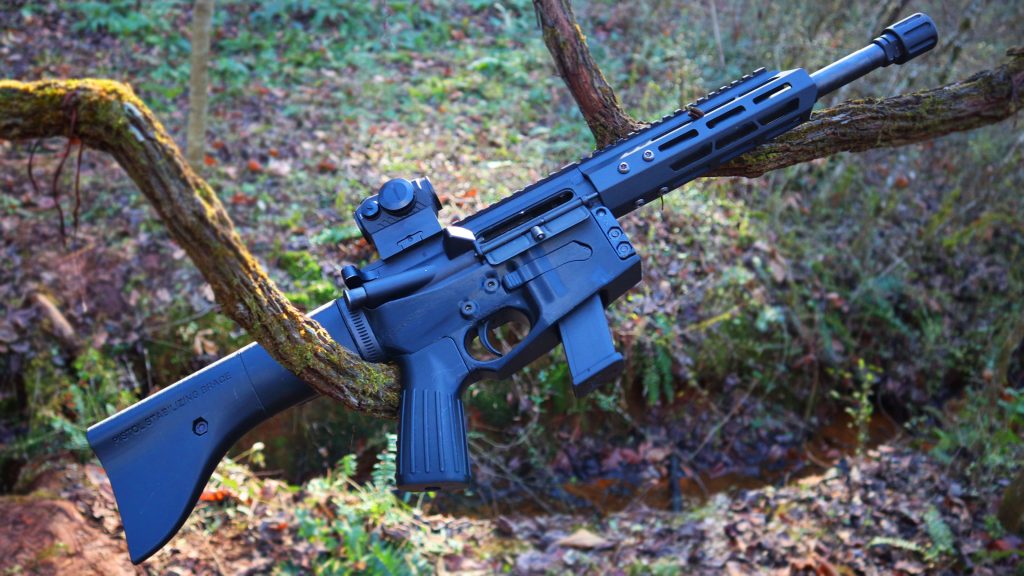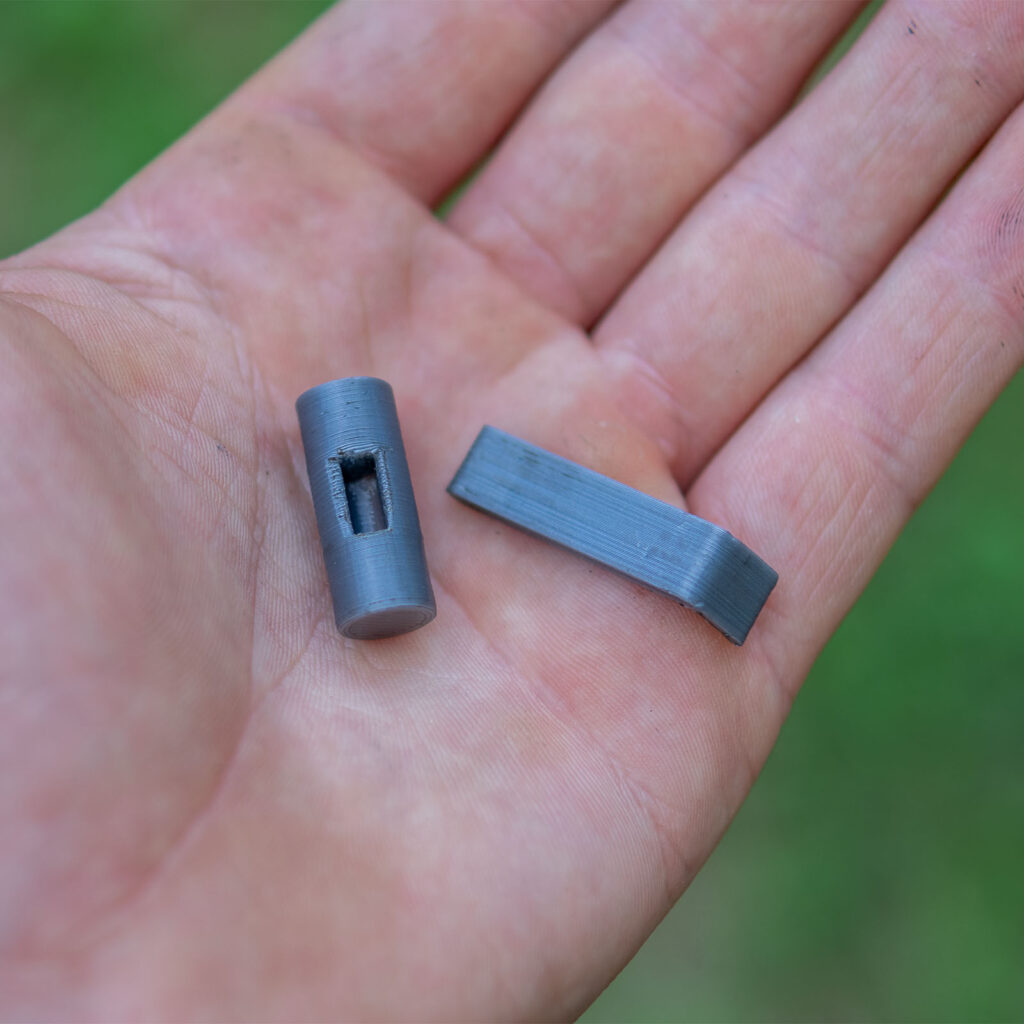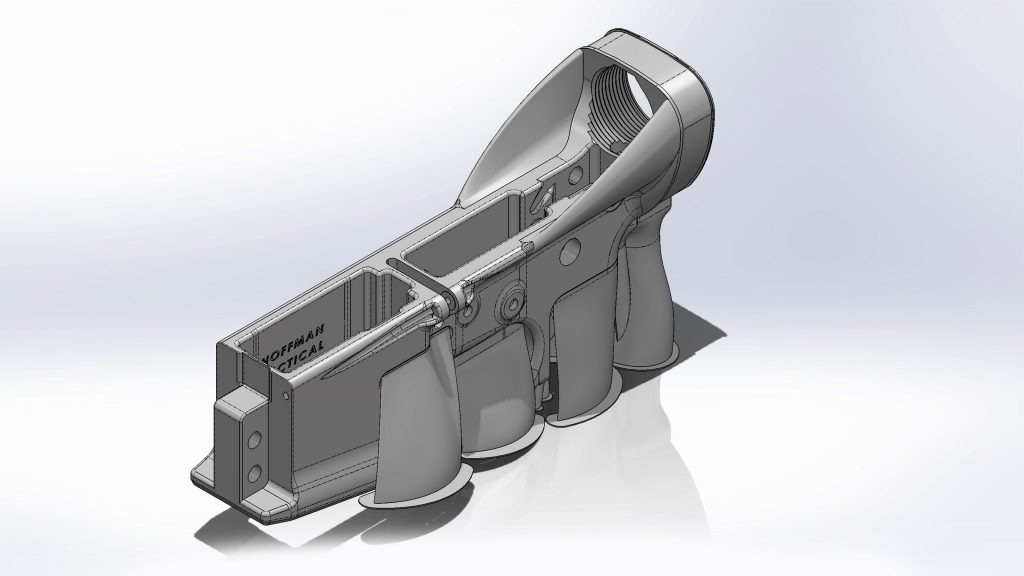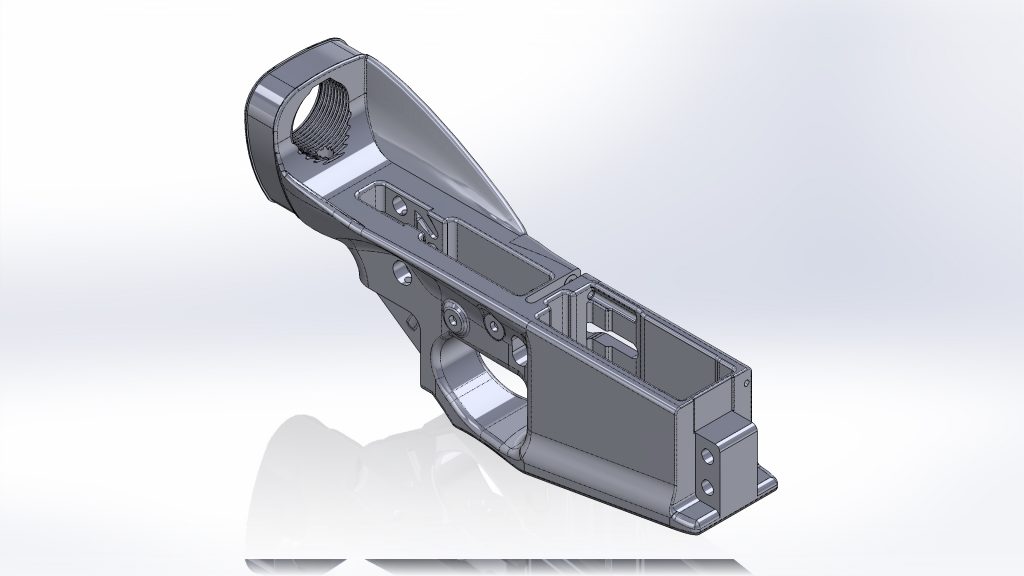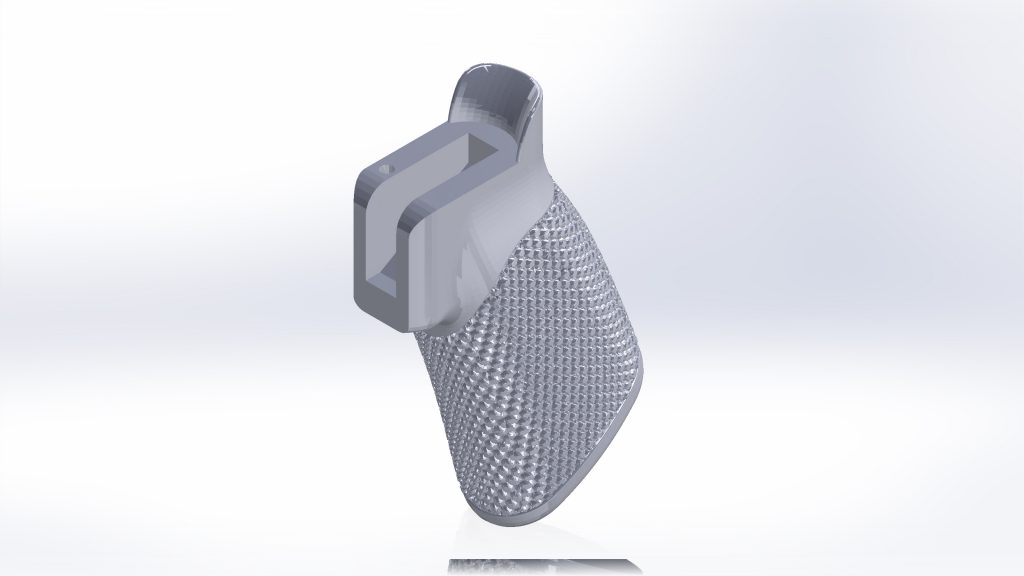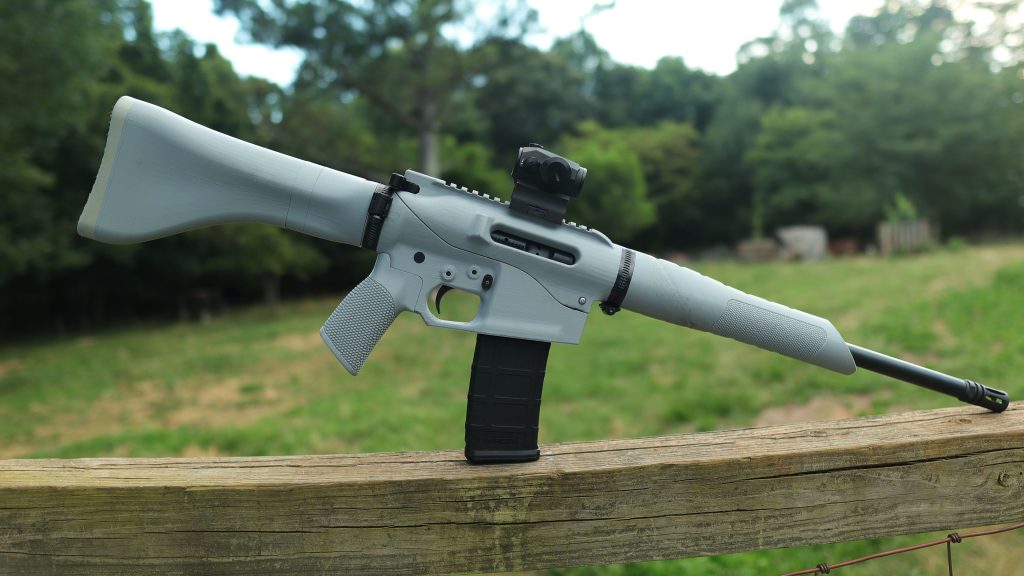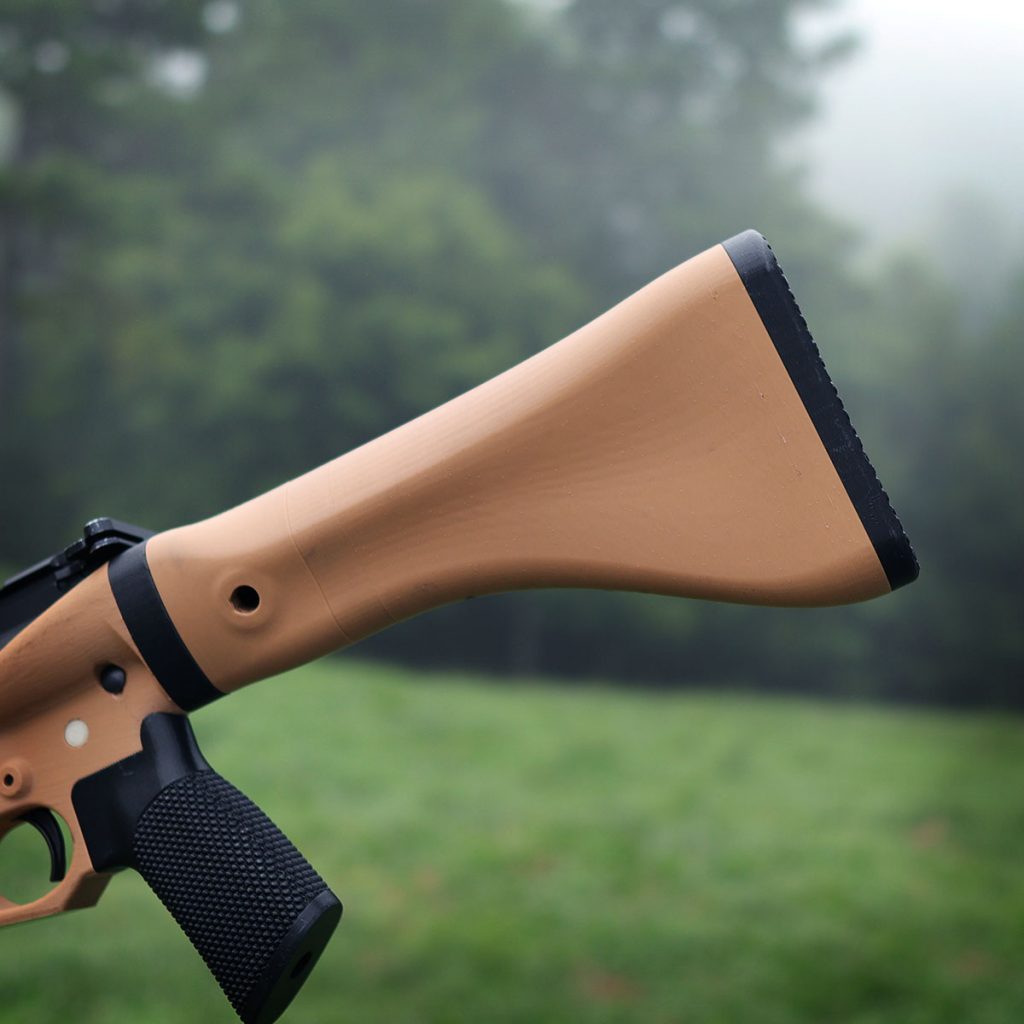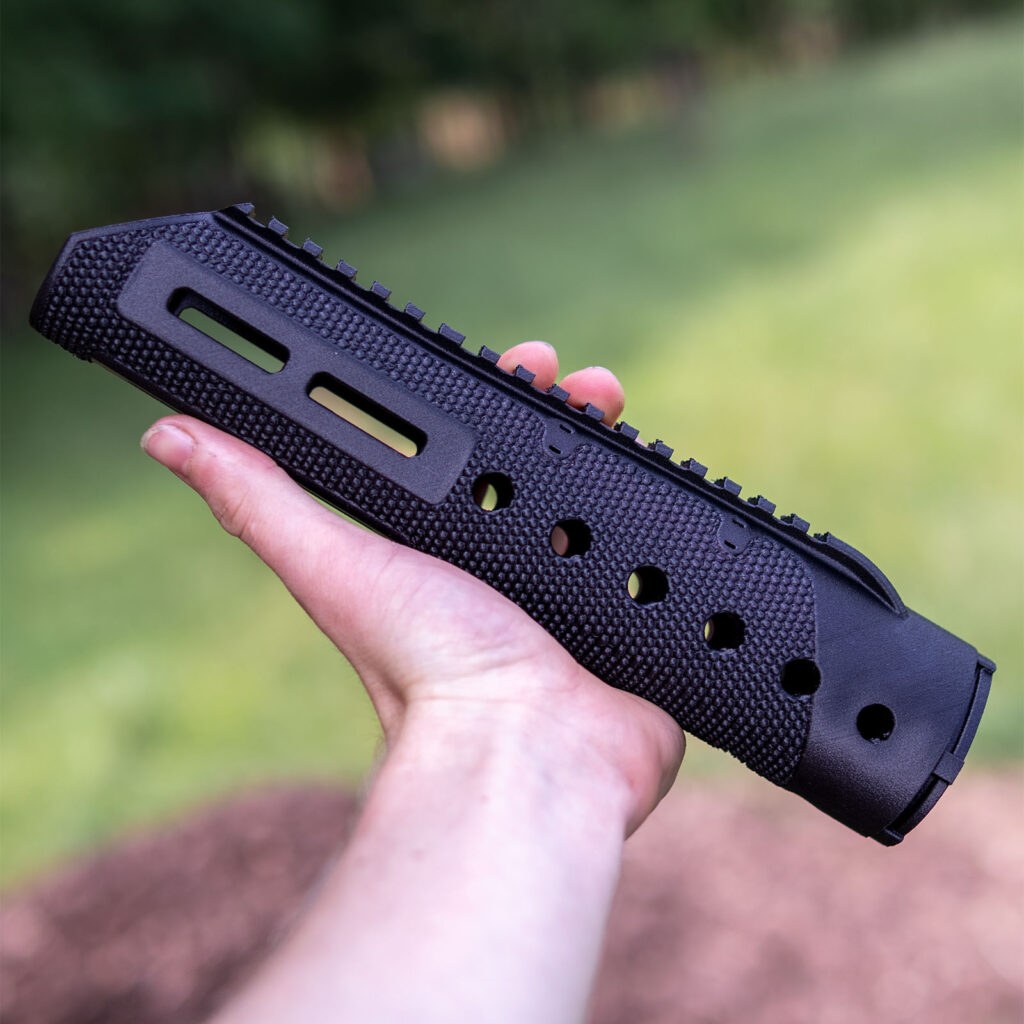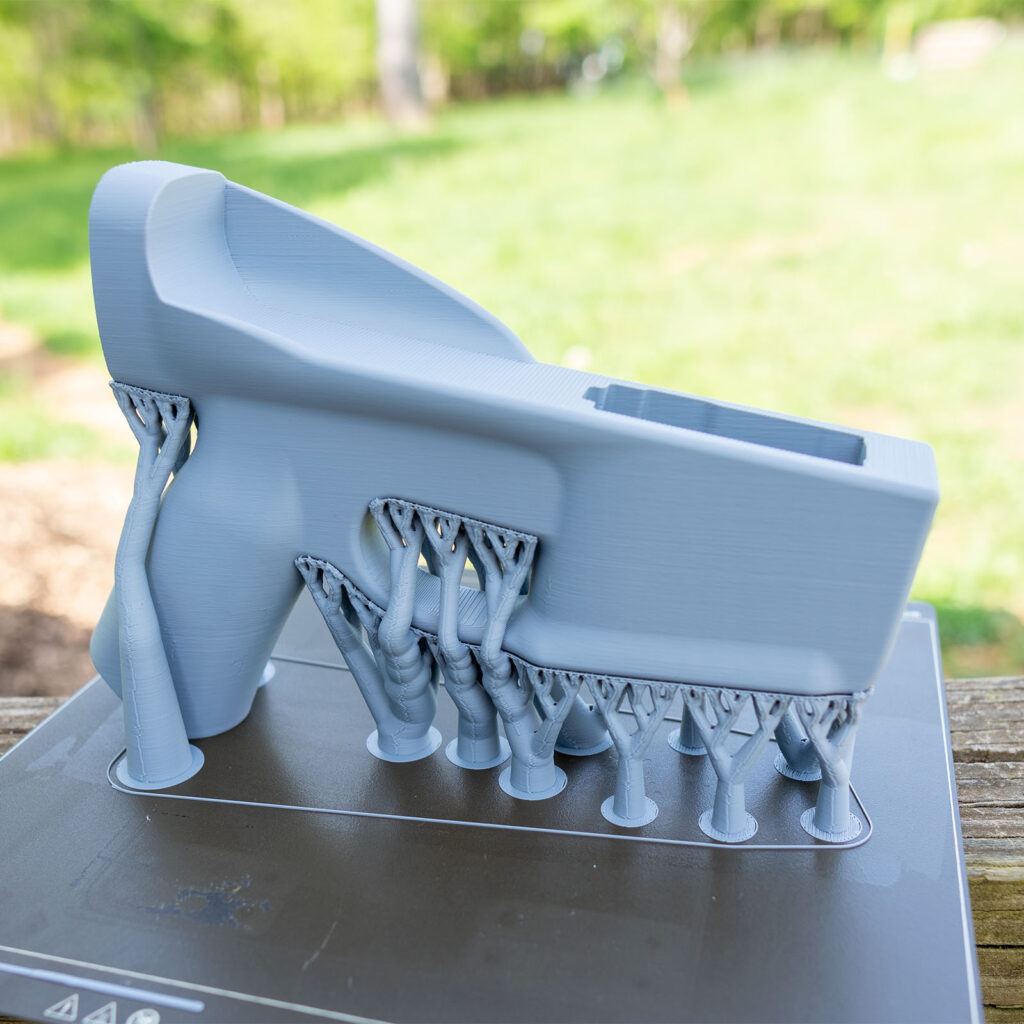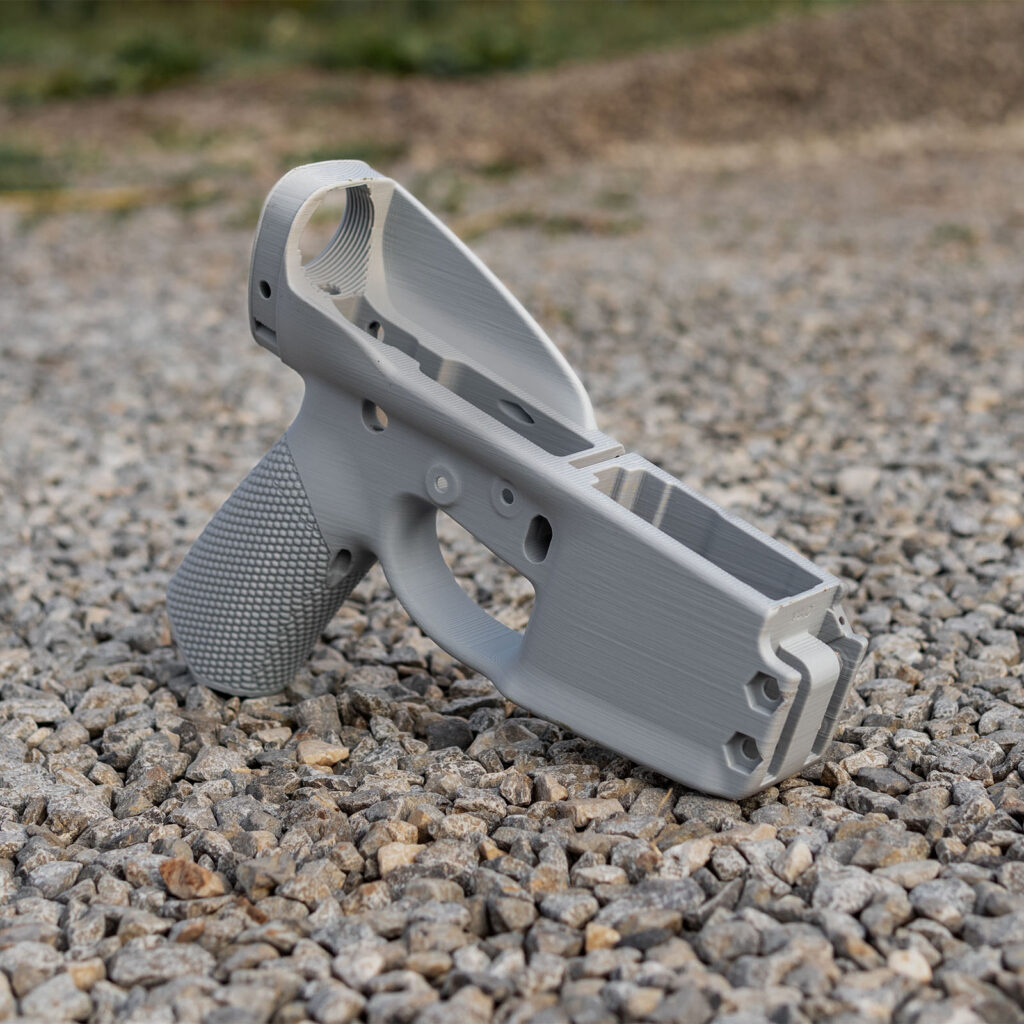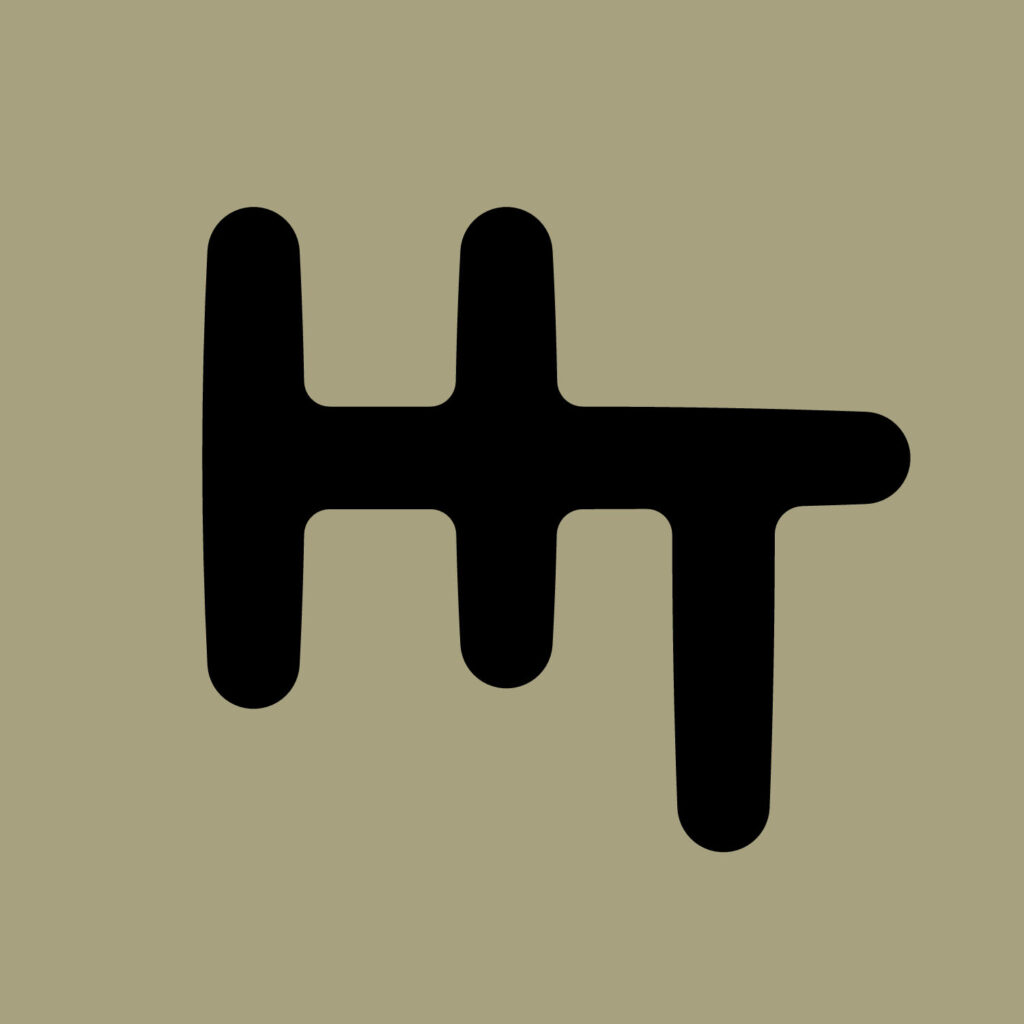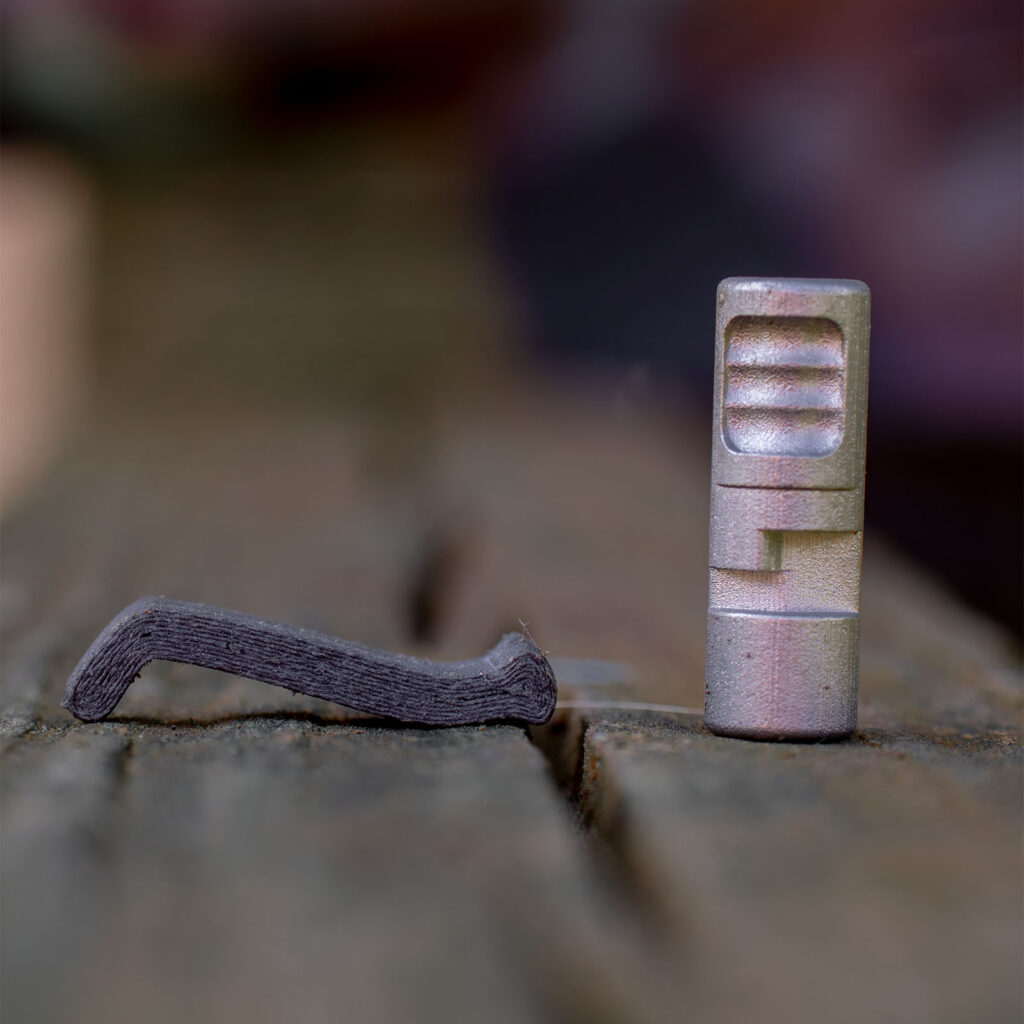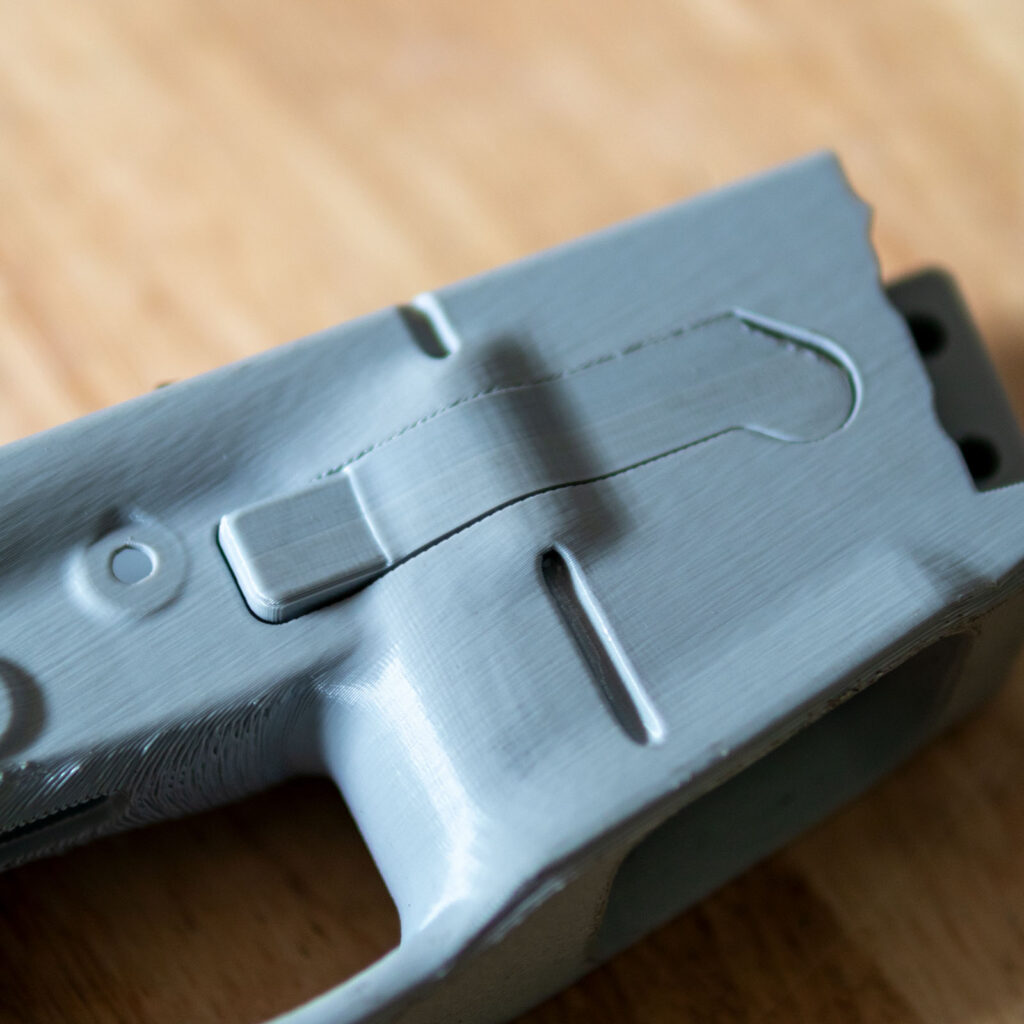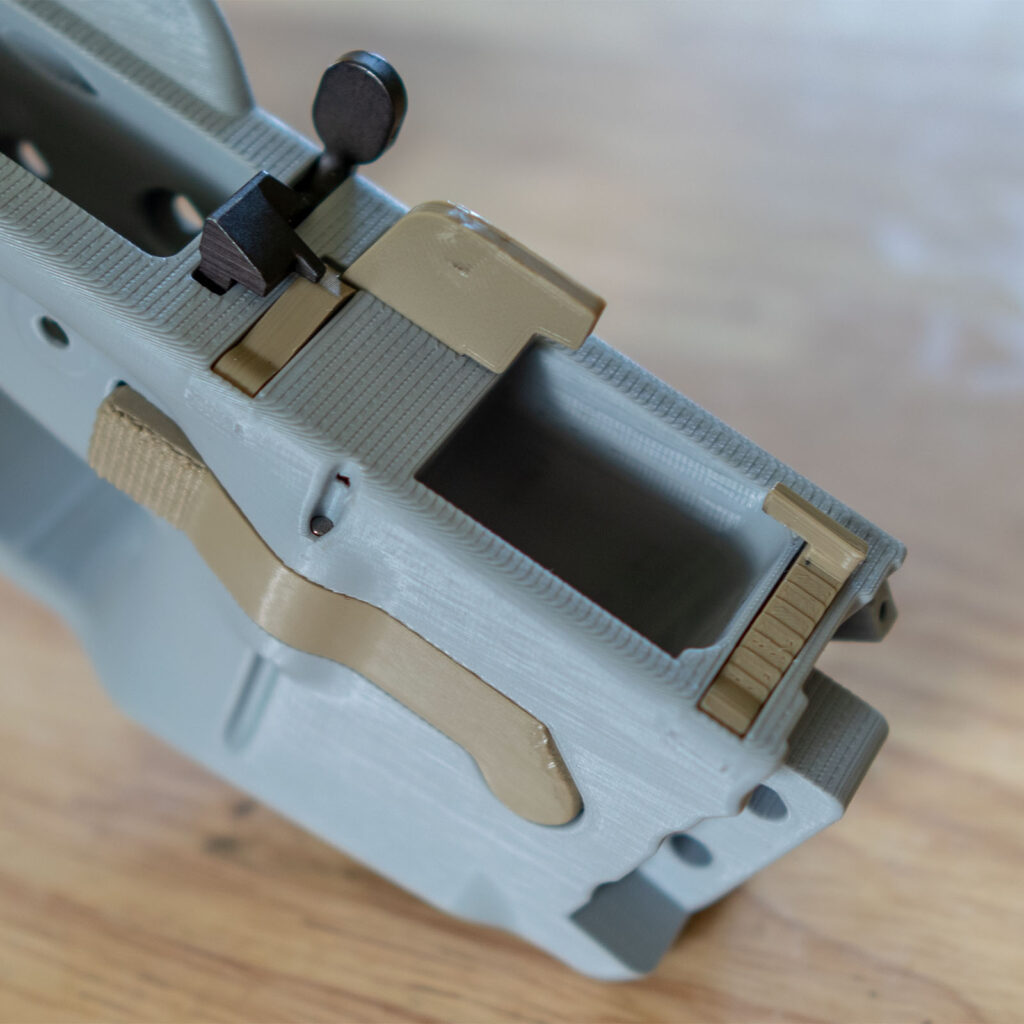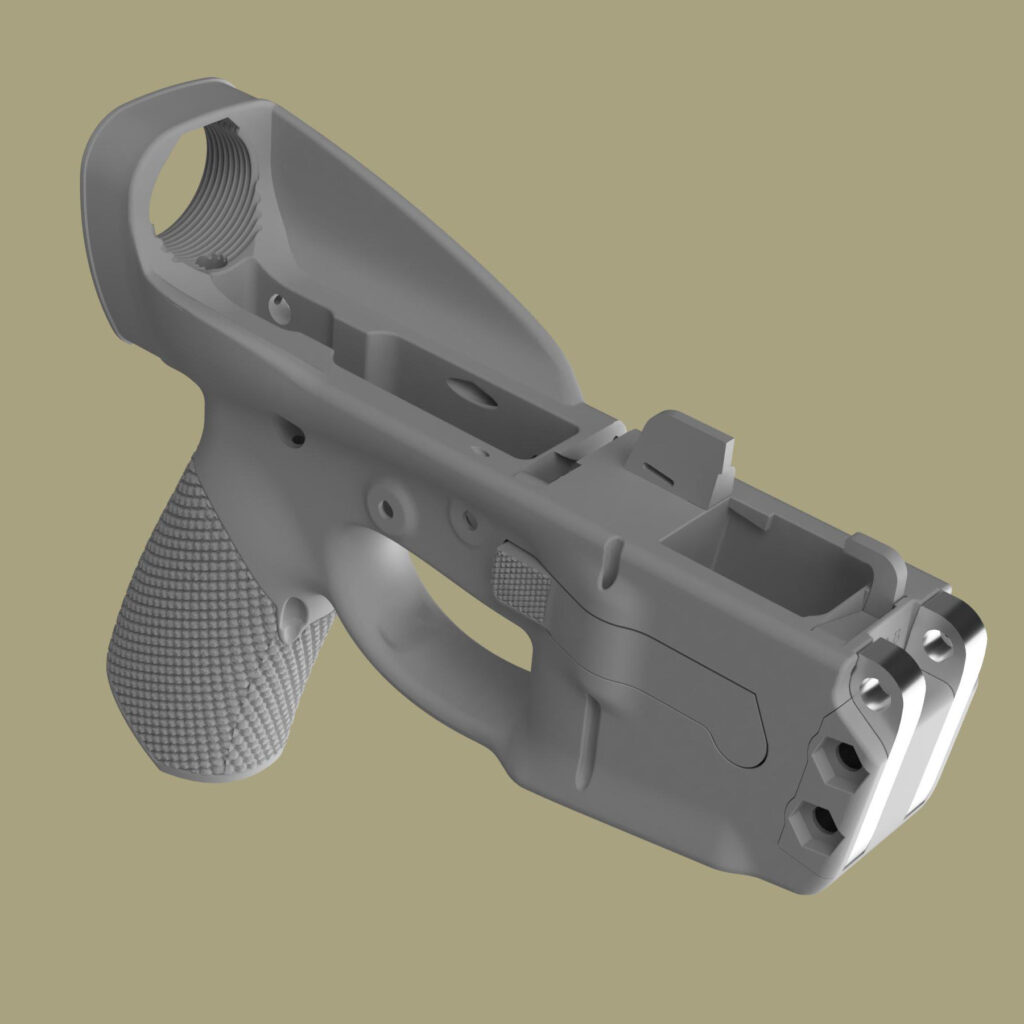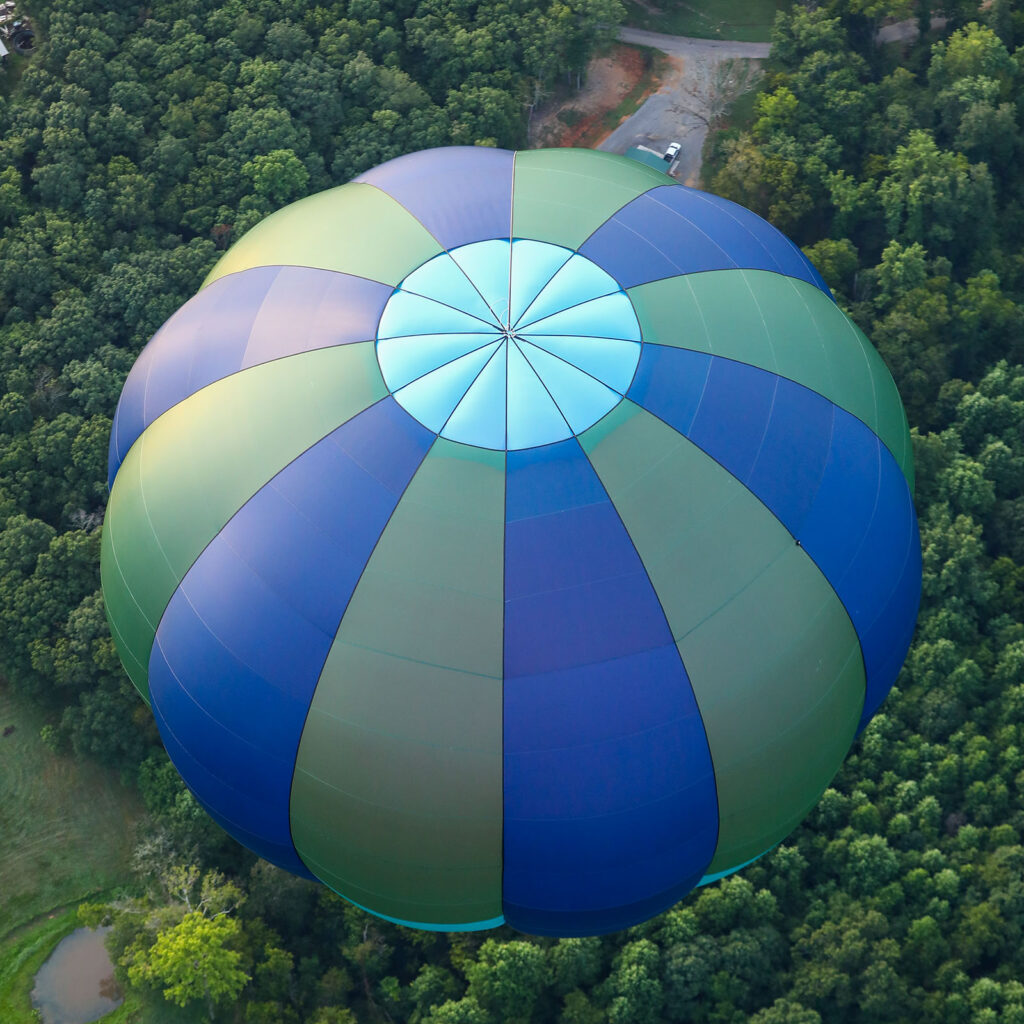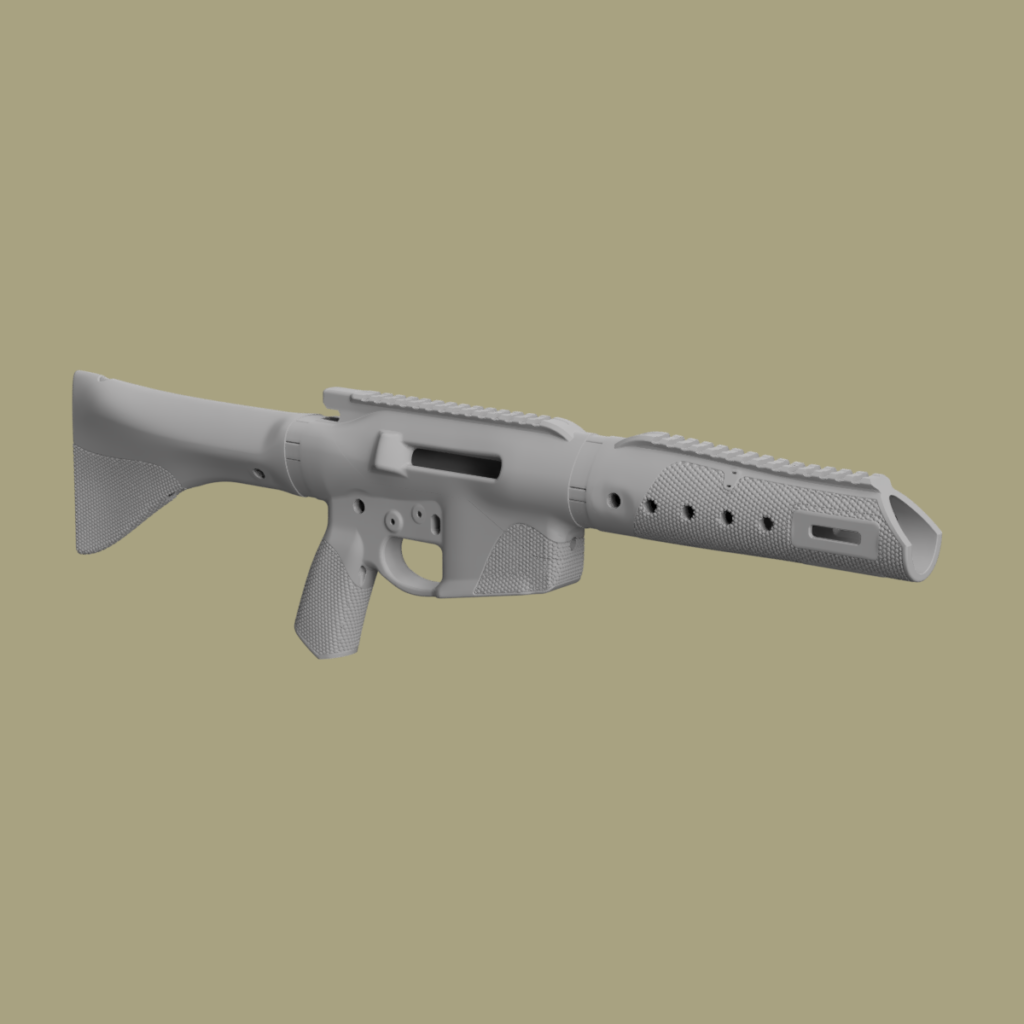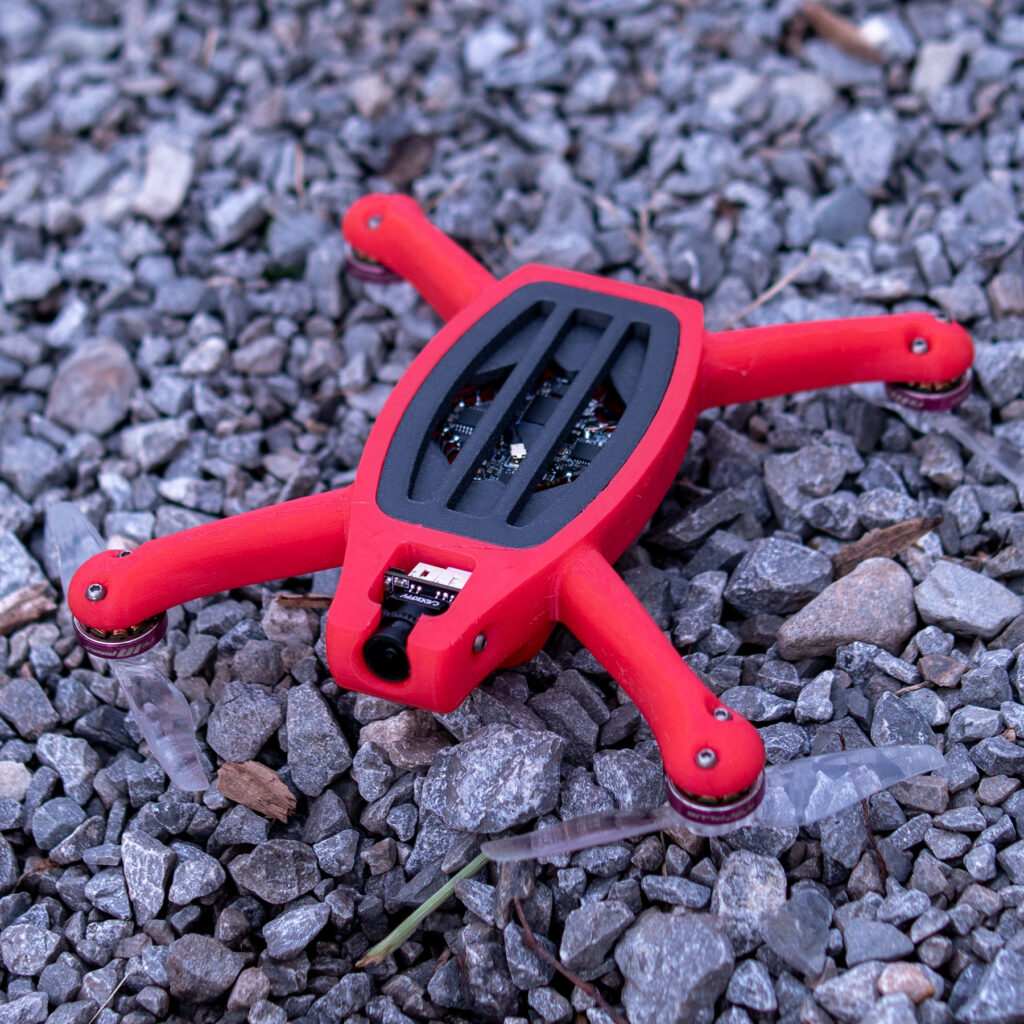History of Development
Printing an AR-15 lower receiver was something I wanted to try when I bought my first printer. But trying to find files early 2020 proved to be difficult. The only design I could find was Drsails lower on Pinshape.com. After downloading his files I soon found that they where not dimensionally accurate, so I decided to design from scratch. One feature of Drsails lower I borrowed was the print orientation. Printing at a forty five degree angle allows for almost no support material to be used, which was very attractive to me at the time.
My first two lowers where basically a “mil spec” profile. No reinforcement was used. V2.0 and V2.1 both failed after two and five rounds respectively. The latter is shown above. The failures where only partly due to the lack of reinforcement. PETG and less then 100% infill also added to there demise.
I knew something had to be done to reinforce the buffer tower. After much time looking at the lower trying to see where I could add more plastic, I struck upon the idea of the support rib. This feature is the key to all of the Hoffman Tactical lower designs. V2.2 fired over 60 rounds without buffer tower failure. It did fail, but as a result of poor handling during take down. The front take down pin lugs cracked.
Beefed up. V2.2 worked but had lots of problems. Many of the walls where too thin to withstand abuse. V2.4 corrected much of this. But no large design changes where made.
Another change was made that is almost as important as the support rib. I moved the rear take down pin from the right side to the left side of the lower. On older designs the right side had a large counter bore cut to allow the head of the pin to seat. By moving this to the left side the right side becomes much stronger. The left side was not effected because the support rib added enough strength. This change along with the support rib are still in use today.
This test was completed using a V2.6 lower printed from carbon fiber PETG. The lower fired over 100 rounds without any malfunctions.
Another important change was made. The buffer tower was thickened by 0.150″. This made it significantly stronger, enabling the lower to pass the push up test. The downside of this was that the lower no longer worked with some buffer tubes. Only carbine tubes with enough extra threads would work. Still the change was worth it.
I became aware of the Hellfire lower early December. It used the same style of buffer tower reinforcement, but in the form of a bolt. I printed it out and tested it, the strength was impressive for such a lightly built lower. The Hellfire was the inspiration for two very important things. Built in support and the front take down pin plates.
This was a proof of concepted. Up until this time my lowers always failed about halfway up the buffer tower. I wanted to move this failure point to the neck which has a much larger cross section. Which would make the lower much stronger. I had become aware of the U-Bolt Vanguard lower by this time and the U-bolt was the inspiration for the hose clamp. The U-Bolt was not a good option for my lowers as it did not take advantage of the support rib, so after much thinking I stuck upon the hose clamp which clamps the entire…Read More
At this point I wanted to fine tune the lower. I started doing this by adding some small brass inserts. These consisted of the brass bushings for the hammer and trigger pins, as well as a captured nut for the pistol grip. These parts where first introduced before the Super Lower.
I made several versions of the finale angled lower design. Some of these even had a rib on both sides to fit slab sided uppers. Bushing pockets where also used to allow metal reinforcement.
A Giant Leap Forward. I decided that my designs needed a make over. Starting from scratch I rethought the entire lower design and the result was the Super Lower. It included all of the older improvements such as the hose clamp, front pin plates and build in support. The big change from older lowers was the print orientation. Rather then the old forty five degree angle I opted for a ten degree print angle with the base of the mag well resting on the bed. This made supporting the lower during printing a challenge. Much refinement was necessary to minimize…Read More
V2.5 was a much improved version of the V2.4 AR-15 Super Lower. A flared mag well, more streamlined design and improved fit made it much better. Another important change was made with V2.5. The front take down pin was mirrored so as to match the rear take down pin.
After the success of the first Super Lower I decided to scale it up to an LR-308 lower. This became the first reliable 3D printable LR-308 lower.
One of my goals with the Super Lower is to provide a comprehensive lower package. And this should include the furniture needed to complete the rifle. Why buy a stock when you can print a much better one? That was my thought when I designed the stocks and pistol grips.
These version came with better support and overhangs. As well as refined fit. The LR-308 Lower was also refined to match the AR-15 lowers.
While V2.8 was a rather minor update, one important change was made. The support rib was redesigned to eliminate interference issues with the popular Bear Creek Arsenal uppers.
The original stock design worked quite well. But had it’s limitations. The Gen 2 Stock System is more modular and even has the option for a TPU butt pad.
Besides the normal refinements to the fit and finish of the lower. V3.0 boasts a redesigned right side. Resembling the right side of the later forty five degree lowers, V3.0 has a much stronger neck then the older Super Lowers did.
After many requests I have designed and released my first 9 x 19 AR-9 lower. It uses Glock mags and features a fully 3D printed ejector and mag catch.
After a week of development, the first Super Safety is successfully tested with good results.
The double rib lower is the first of a new series of lowers. The addition of the rib on the right side allows for the lower part of the right side to be slim and flat. This in turn allows for the use of most ambidextrous equipment.
The V2.6 was a huge leap forward. The previous release was V1.4, dating from back in 2021. V1.4 was fully redesigned for better fit. finish and strength. The built in support was also optimized.
After more then a year of the V1.0 grips, the new grips where finally released. V3.1 has a improved profile, and are designed to fit the new standardized backstrap which all of my lowers will be using. V3.1 also includes texturing.
The Orca project is a 3D printed AR-15 upper and lower. Designed to use as many 3D printed parts as possible, while still being a practical and fully functional rifle.
The Gen 3 stock system was a big improvement over the older Gen 2 system. A positive retention mechanism is used to retain the stock, unlike the Gen 2 stock which used friction.
This was a simple project, but one that I should have done sooner. The TPU cover pops over the worm drive mechanism on the hose clamp and prevents scratches and cuts from the sharp edges.
The Orca was a big milestone. Printing as many of the AR-15 parts as possible, it was a big step forward. Opening up a lot of possibilities for the future.
This was a improved Orca handguard that featured M-LOK slots and a picatinny rail. It was released under the V5.3.B Orca upgrades.
V4.x is a fully redesigned lower to replace the older V3.1 Super Lower. The “x” represents the subversion that have not yet been developed. The Naming scheme was also changed to “SL-15”, SL standing for “Super Lower”. The new SL-9 lower will be based off of the V4.x SL-15 lower.
Most of the features of the new V4.x lower have been developed. The small details remain, the hardest part to get right.
The Super Safety is an active reset trigger mechanism that replaces the standard safety selector on AR pattern firearms. After more than a year of development, the Super Safety was released to the public.
Development of the new SL-9 lower begins, based of of the new V4.x lower. Improved mag catch and a last round bolt hold open system are priorities.
The new SL-9 lower with a reliable last round bolt hold open is tested with great success.
The fully updated SL-9 lower based off of the improved V4.8 SL-15 lower is released. This lower features a reliable DIY last round bolt hold open.
After several years of thought, a helical magazine mockup was finally designed and tested. This is part of a larger 22 LR machinegun project to replace the American 180.
Based off of the latest V4.8 SL-15 lower, the SL-308 V3.9 is a fully updated LR-308 lower featuring the improved geometry, integrated grip, and a ton of minor tweaks.
